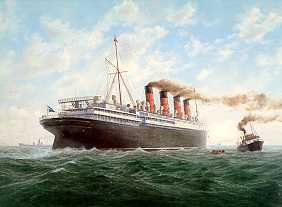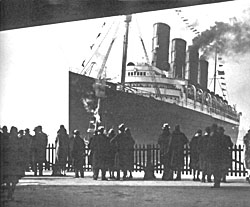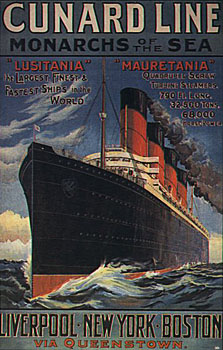|
SHIPSPowys claims he made about fifty Atlantic crossings. According to Anthony Head the figure was closer to 32! In his letters he mentions many ships, such as the Ivernia (December 1904), the Oceania (1905), the Lucania, (December 1908) where the "best 2nd class berth cost ten guineas", the Saint Louis (December 1909), the Lusitania (September 1910), the Baltic (October 1912), the Caronia (1912 and 1913), La Lorraine, (April 1913), the Mauretania (1914), the Adriatic (1918), and the Megantic in 1918. In June 1918 he sailed to England "in a regular fleet of eleven great liners, all sailing near one another, a curious experience". After the war he mentions the Adriatic (April 1920), the Aquitania (1920 and August 1922), the Celtic and the Cedric in 1924, the Berengaria (March 1926), the Majestic (1929), the Olympic (Summer 1929) and the Westernland in 1934... |
Powys evokes with pleasure the Mauretania :
The Mauretania was, and will always be, my favourite liner. I derived extraordinary satisfaction from going forward once, to the extremest prow of this splendid ship, and watching the way it cut the water like a horizontal guillotine.
(Autobiography)
 |
|
print on sale from Buccaneer Distributions |
 |
|
from the mysterious "Ordrazz" liner photographs |
The Mauretania was launched for Cunard in September 1906 at the Swan Hunter shipyard on Tyneside. On her maiden voyage in November 1907, she made the trip between Liverpool and New York in five days, 18 hours and 17 minutes at an average speed between 21 and 22 knots, just short of the westbound record. On November 30th, 1907 the ship managed to capture the eastbound record with an average speed of 23.69 knots. It was not however until September 1909 that the Mauretania claimed the record for the fastest westbound crossing, a record she would then retain for over 20 years.
In the TLS review by E.S. Turner (September 5, 2003) of The Ocean Railway by Stephen Fox, Harper Collins, 2003, we can read the following:
Fox hails the Mauretania as "the greatest steamship ever built". No other vessel, he says, "so combined technical innovation, speed, beauty, profitability and longevity". She was "a lucky, happy ship, encountering no major disasters"...
|
|
